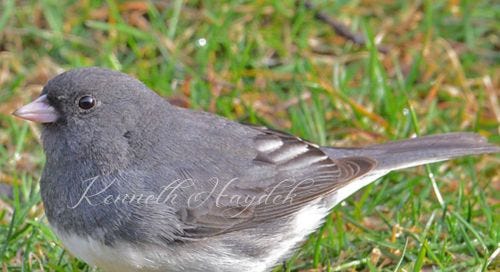'Tis the season for snowbirds
When seasons change to fall and then winter, and cool weather causes your cheeks to blush, be on the lookout for these rosy-billed birds.
December: Slate-Colored Juncos
Last month, we looked at the dickcissel, a migratory songbird, who fits much of our typical idea of flying “south for the winter”—that is, waaay south, to someplace with a steady warm climate, possibly tropical. Today we introduce to you another sweet little songbird, but one whose idea of flying south may mean wintering in a place as “warm” as the upper Midwest in December: Meet the slate-colored junco.
For many in central and eastern portions of the United States, the sight of slate-colored juncos in their backyards heralds cold weather, a migratory characteristic that has earned them the appellation “snowbird.” Indeed, the coloring of these birds is well-suited for a winter snowscape: adults males have cool gray heads, backs, and wings, reminiscent of a snowcloud-covered sky. Their white bellies and long white outer tail feathers complete something of a winter-horizon ensemble. Female juncos tend to be paler gray, sometimes tinged with brown- and pink-ish feathers up top.
The long white outer tail feathers, which flash conspicuously when taking flight, and silky pink bills of the slate-colored junco are common features of the dark-eyed junco species, of which slate-colored juncos are a subspecies. Belonging to the sparrow family, dark-eyed juncos’ appearances vary greatly by region, having as many as 15 different varieties, though six are most frequently spotted in the field.
Among the dark-eyed junco species, the slate-colored junco variety has the broadest range across North America. During breeding season, they can be spotted across Alaska and Canada; in winter, they can be found throughout a wide swath of United States, mostly east of the Rocky Mountains, stretching from the Gulf of Mexico all the way to the Canadian border and beyond.
When they migrate, slate-colored juncos often join flocks of other birds, like sparrows, bluebirds, and additional dark-eyed juncos, who are known for their continuous wing-flapping and tail-pumping in flight. On the other hand, some juncos never migrate at all, or if they live in Appalachia, they may spend the summers at higher altitudes and come down to lower elevations for the winter.
Dark-eyed juncos like to spend their springs and summers in coniferous or semi-coniferous forests and head out to opener areas, like fields and gardens, in the winter. When it comes to finding a mate, both males and females participate in a courtship display by hopping on the ground and fanning their tails. Female juncos tend to build their nests on or near the ground, while male juncos defend their territory by singing loudly from a height. In breeding season, about half of their diet comes from insects and the other half comes from seeds and grains, all of which they forage mostly while hopping around on the ground. In fall and winter, their diet shifts to mainly seeds and grains, of which millet and black-oil sunflowers seeds are a heavy favorite in backyards.
Because these little birds are ground foragers, you may not see them up at your feeder. Instead, you may sight slate-colored juncos underneath your feeders, eating bits that have been brushed away by other birds up above. If slate-colored juncos are a regular winter guest in your backyard, or if you’d like to make your backyard more inviting for these snowbirds, consider using a ground tray feeder, as described here, to attract them, starting in the fall. Migrating adults may return to the same general area and feeders each autumn. And while they are in your neighborhood, be sure to listen for their pretty metallic trill, which, if one is poetic enough, may be thought of as the perfect accompaniment to sleigh bells.
Sources:
https://www.allaboutbirds.org/guide/Dark-eyed_Junco/id
https://www.audubon.org/news/dark-eyed-juncos-backyard-gems-come-dazzling-array-colors
https://www.birdsandblooms.com/birding/dark-eyed-juncos/
https://www.birdsandblooms.com/birding/bird-species/sparrows/attract-juncos-backyard/
https://www.birdsandblooms.com/birding/bird-photography/junco-bird-pictures/
https://www.birdsandblooms.com/birding/birding-basics/junco-vs-chickadee/
https://www.birds-of-north-america.net/Dark-eyed_Junco_Slate-colored.html
https://www.migrationresearch.org/mbo/id/scju.html
https://www.audubon.org/field-guide/bird/dark-eyed-junco
https://abcbirds.org/bird/dark-eyed-junco/



